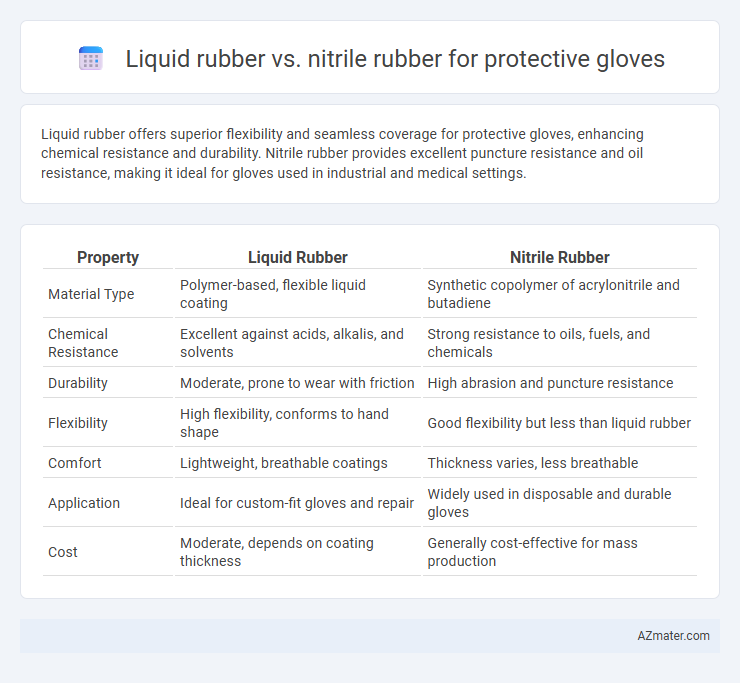Liquid rubber offers superior flexibility and seamless coverage for protective gloves, enhancing chemical resistance and durability. Nitrile rubber provides excellent puncture resistance and oil resistance, making it ideal for gloves used in industrial and medical settings.
Table of Comparison
| Property | Liquid Rubber | Nitrile Rubber |
|---|---|---|
| Material Type | Polymer-based, flexible liquid coating | Synthetic copolymer of acrylonitrile and butadiene |
| Chemical Resistance | Excellent against acids, alkalis, and solvents | Strong resistance to oils, fuels, and chemicals |
| Durability | Moderate, prone to wear with friction | High abrasion and puncture resistance |
| Flexibility | High flexibility, conforms to hand shape | Good flexibility but less than liquid rubber |
| Comfort | Lightweight, breathable coatings | Thickness varies, less breathable |
| Application | Ideal for custom-fit gloves and repair | Widely used in disposable and durable gloves |
| Cost | Moderate, depends on coating thickness | Generally cost-effective for mass production |
Introduction to Protective Glove Materials
Protective gloves made from liquid rubber and nitrile rubber offer distinct advantages based on their material properties. Liquid rubber provides excellent flexibility and waterproofing, making it ideal for applications requiring tight seals against liquids and chemicals. Nitrile rubber is known for its superior resistance to oils, punctures, and abrasion, widely used in medical, industrial, and chemical handling industries for enhanced durability and protection.
Overview of Liquid Rubber and Nitrile Rubber
Liquid rubber is a versatile polymer coating known for its excellent elasticity, chemical resistance, and waterproofing capabilities, making it ideal for enhancing the durability of protective gloves. Nitrile rubber, a synthetic copolymer of acrylonitrile and butadiene, offers superior puncture resistance, oil resistance, and hypoallergenic properties compared to natural rubber, widely used in glove manufacturing for medical and industrial applications. Both materials provide critical protection, with liquid rubber often applied as a coating layer, while nitrile rubber serves as a robust glove base material.
Chemical Composition and Properties
Liquid rubber, primarily composed of silicone or polyurethane polymers, offers excellent flexibility, waterproofing, and resistance to a broad spectrum of chemicals, making it ideal for protective gloves exposed to harsh environments. Nitrile rubber, a synthetic copolymer of acrylonitrile and butadiene, provides superior resistance to oils, fuels, and many solvents along with high puncture and abrasion resistance, commonly used in chemical handling gloves. The chemical structure of nitrile rubber results in greater resilience to petroleum-based products, whereas liquid rubber coatings emphasize enhanced elasticity and protection against water-based contaminants.
Durability and Resistance to Chemicals
Liquid rubber offers excellent flexibility and strong chemical resistance, making it ideal for protective gloves exposed to corrosive substances and solvents. Nitrile rubber provides superior puncture and abrasion resistance, enhancing durability in gloves used for mechanical tasks and protection against oils, greases, and certain chemicals. Both materials excel in chemical resistance, but nitrile rubber typically outperforms liquid rubber in durability under harsh physical conditions.
Comfort and Flexibility Comparison
Liquid rubber gloves provide superior flexibility and a snug fit, enhancing user comfort during prolonged use due to their ability to conform closely to the hand's shape. Nitrile rubber gloves offer excellent durability and chemical resistance but are generally less elastic, which can result in a stiffer feel and reduced tactile sensitivity. For applications requiring extended wear and dexterity, liquid rubber gloves outperform nitrile in comfort and flexibility metrics.
Grip and Tactile Sensitivity
Liquid rubber gloves offer superior grip due to their flexible coating that adapts to various surfaces, enhancing slip resistance in wet or oily conditions. Nitrile rubber gloves excel in tactile sensitivity, providing a close fit and excellent dexterity for precision tasks while maintaining chemical and puncture resistance. Selecting between liquid rubber and nitrile rubber depends on the specific need for enhanced grip or heightened tactile feedback in protective glove applications.
Allergic Reactions and Skin Safety
Liquid rubber gloves provide excellent skin safety due to their hypoallergenic properties and minimal risk of allergic reactions, making them suitable for individuals with latex sensitivity. Nitrile rubber gloves also offer good protection against allergens, as they are latex-free and resistant to chemicals, but some individuals may experience contact dermatitis from certain accelerators used in the manufacturing process. Both materials prioritize skin safety, but liquid rubber gloves are often preferred in environments requiring reduced allergenic potential.
Applications in Various Industries
Liquid rubber offers superior flexibility and chemical resistance, making it ideal for protective gloves used in harsh chemical handling, automotive manufacturing, and construction industries. Nitrile rubber excels in puncture and oil resistance, commonly employed in medical, food processing, and pharmaceutical sectors where hygiene and dexterity are critical. Both materials provide excellent protection, but industry-specific requirements guide the optimal choice between liquid rubber and nitrile rubber gloves.
Environmental Impact and Sustainability
Liquid rubber, often made from natural or synthetic polymers, offers enhanced environmental benefits due to its biodegradability and lower volatile organic compound (VOC) emissions compared to nitrile rubber. Nitrile rubber, derived from petroleum-based synthetic materials, presents challenges in sustainability because of its non-biodegradable nature and energy-intensive production process. Choosing liquid rubber gloves can reduce ecological footprints through improved recyclability and decreased hazardous waste generation.
Choosing the Right Material for Protective Gloves
Liquid rubber offers superior flexibility and seamless coverage, making it ideal for gloves requiring a close fit and high dexterity, while nitrile rubber provides excellent resistance to oils, chemicals, and punctures, suited for industrial and medical applications. Selecting the right material depends on the specific hazards faced; nitrile excels in chemical resistance and durability, whereas liquid rubber enhances comfort and tactile sensitivity. Understanding the balance between protection level and flexibility is crucial for optimizing glove performance and user safety.

Infographic: Liquid rubber vs Nitrile rubber for Protective glove
 azmater.com
azmater.com